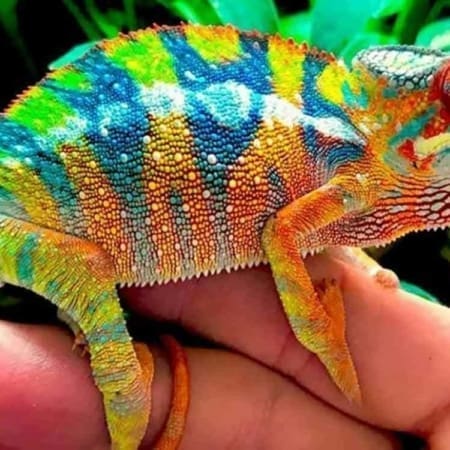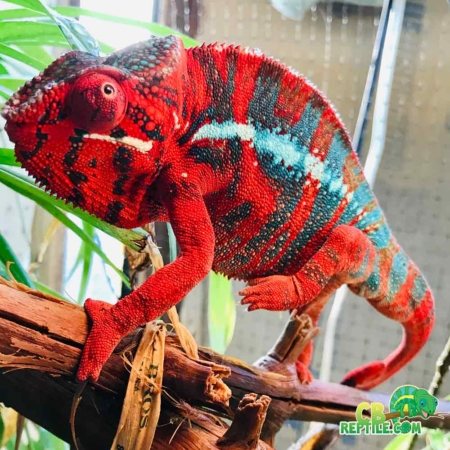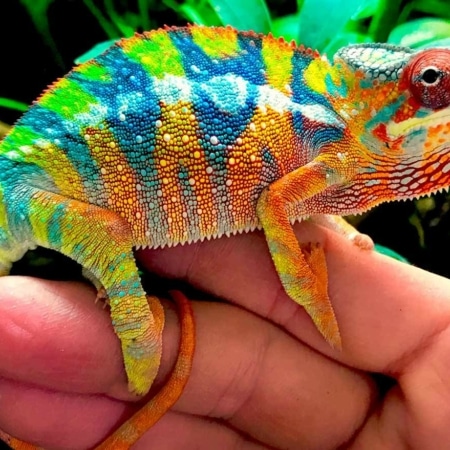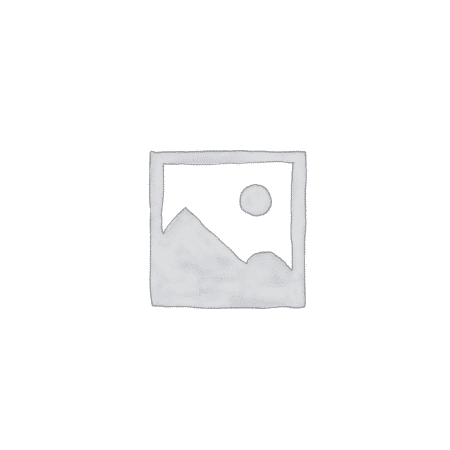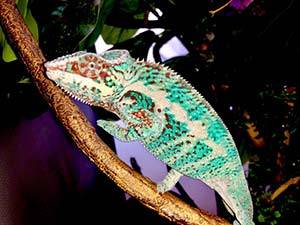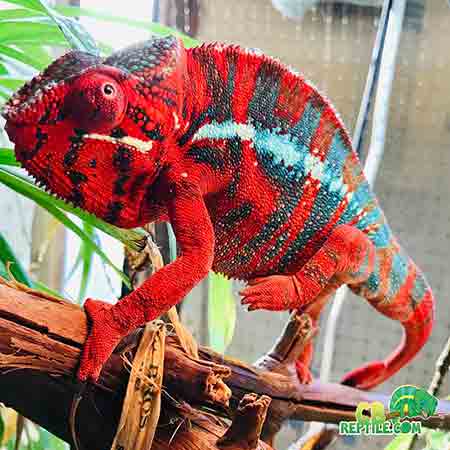Panther Chameleon Diet & Nutrition From Hatchling to Adult
Feeding a panther chameleon correctly from hatchling to adulthood is one of the most important parts of long-term health and color development. A well-structured diet supports bone density, vibrant coloration, immune strength, reproductive health, and steady growth. While panther chameleons are insectivores, not all feeders are equally nutritious, and not all feeding schedules are appropriate for every age range. Understanding how nutrition changes from a tiny hatchling to a fully grown adult is critical for responsible husbandry.
Because early diet and hydration habits have such a huge impact on long-term health, many keepers choose to start with a well-established baby panther chameleon that is already eating consistently and used to a diverse feeder rotation. From there, it’s all about maintaining and building on those foundations.

Core Principles of Panther Chameleon Nutrition
Regardless of age or locale, a healthy panther chameleon diet is built around four pillars:
- Feeder variety — offering multiple insect species
- Gut-loading — feeding the insects high-quality foods before offering them to the chameleon
- Supplementation — correct use of calcium and vitamins
- Hydration — supporting digestion and nutrient absorption
When all four pillars are balanced, growth curves, shedding cycles, and coloration all improve dramatically.
Stage 1: Hatchling Nutrition (0–2 Months)
Hatchling panther chameleons have extremely fast metabolisms and require frequent, appropriately sized meals. At this age, the focus is on tiny feeders and gentle hydration.
Best Feeder Options for Hatchlings
- Flightless fruit flies (D. melanogaster and D. hydei)
- Pinhead crickets
- Very small black soldier fly larvae
- Micro-dubia roaches (only if appropriately tiny)
Feed hatchlings 2–3 small meals per day, offering just enough insects that most are eaten within a few minutes. Overfeeding can leave loose insects in the enclosure that nibble at the baby while it sleeps.
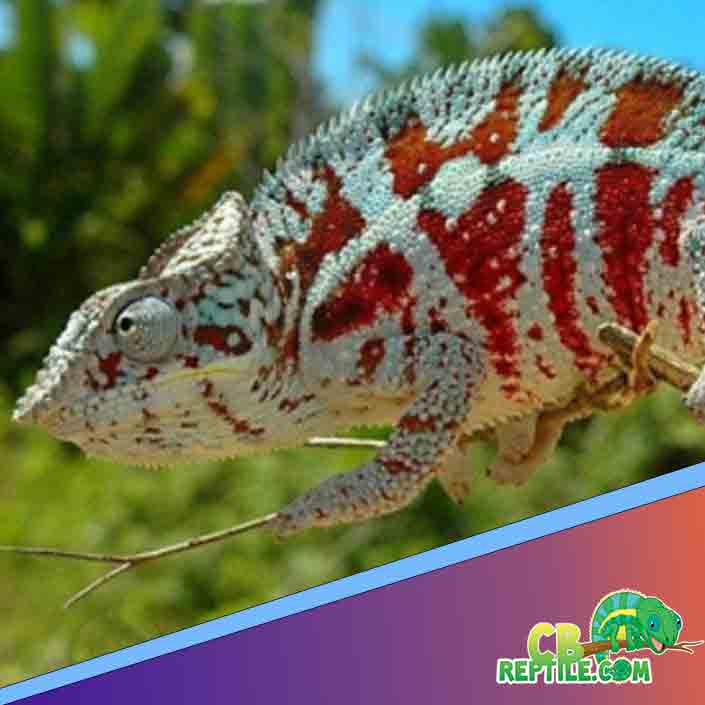
Calcium & Vitamin Support for Hatchlings
Because their bones are growing rapidly, hatchlings need frequent—but very light—calcium dusting:
- Calcium without D3: 4–5 times per week (very light dusting)
- Calcium with D3: about every 2 weeks
- Multivitamin: every 2–3 weeks
Over-supplementation can cause problems, so “light but frequent” is the goal.
Stage 2: Early Juveniles (2–6 Months)
As panther chameleons move into the juvenile stage, their appetite increases and they can handle slightly larger prey. This is when many keepers begin to introduce stronger feeder variety to build muscle and color.
Ideal Feeders for Juveniles
- 3–8 week old crickets (size matched to head width)
- Small to medium black soldier fly larvae
- Small silkworms
- Small hornworms (occasional treats)
- Small dubia roaches
Juveniles often eat once or twice per day. A typical juvenile will consume 10–15 small feeders daily depending on size and growth rate.

Gut-Loading for Maximum Nutrition
Gut-loading means feeding your insects high-quality foods 24–48 hours before offering them to the chameleon. Great gut-load options include:
- Collard greens, mustard greens, dandelion greens
- Butternut squash, sweet potato, carrot
- Orange slices (in moderation)
- Commercial insect gut-load products
Well gut-loaded insects provide higher levels of vitamins, minerals, and moisture, greatly improving overall nutrition.
Stage 3: Sub-Adults & Adults (6+ Months)
By the time a panther chameleon reaches sub-adult and adult stages, nutrition must balance growth support with weight control—especially in females, where obesity can lead to oversized or frequent clutches.
Adult Feeding Frequency
- Males: typically 6–10 feeders per day, once daily
- Females: often benefit from slightly fewer feeders to avoid excessive egg production
Silkworms, roaches, crickets, BSFL, and hornworms can all be part of a balanced adult diet when rotated properly.

Safe & Unsafe Feeder Choices
Some feeders are excellent staples, while others should be used sparingly or avoided.
Excellent Staples:
- Crickets
- Dubia roaches
- Black soldier fly larvae
- Silkworms
Occasional Treats:
- Hornworms
- Superworms (very limited)
- Waxworms (high fat, rare treat only)
Feeders to Avoid:
- Wild-caught insects (risk of pesticides and parasites)
- Insects too large for the chameleon’s head width
- Any insect raised on unsafe or unknown substrates
Hydration & Its Role in Nutrition
Hydration is a major part of digestion and nutrient absorption. Even the best feeders cannot be used efficiently by the body if the chameleon is dehydrated. Hydration also affects kidney health and urate quality.
A properly hydrated animal will have mostly white urates with perhaps a tiny bit of pale yellow. Chalky or orange urates can indicate dehydration.
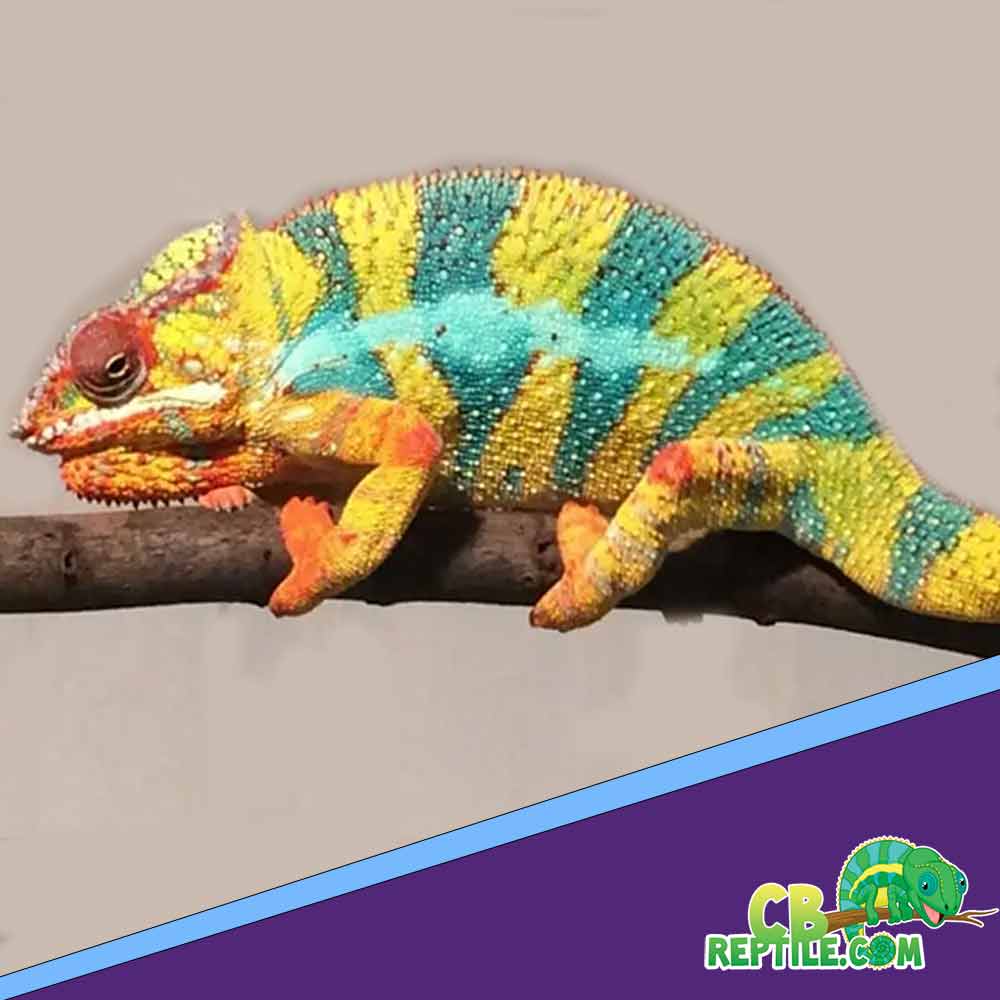
Hydration Strategies:
- 2–3 misting sessions per day for juveniles and adults
- Heavier morning mist to mimic dew
- Light evening mist to reset humidity before lights out
- Optional dripper for prolonged drinking opportunities
Supplements & Preventing Metabolic Bone Disease (MBD)
Metabolic bone disease is most often caused by a combination of poor UVB exposure and incorrect calcium or vitamin use. Even a perfect diet fails if the chameleon cannot metabolize calcium properly.
Typical Supplement Routine:
- Calcium without D3: 3–4 times per week for juveniles and adults
- Calcium with D3: every 2 weeks, depending on UVB strength
- Multivitamin: every 2–3 weeks
Strong UVB lighting (T5HO with proper distance) allows the chameleon to convert D3 naturally for calcium absorption.
Feeding Behavior & Appetite Changes
Panther chameleons are generally enthusiastic eaters when conditions are correct. A sudden drop in appetite may indicate:
- Incorrect temperatures
- Dehydration
- Stress from environmental changes
- Illness or internal parasites
Seasonal appetite dips can also occur, but any long-term change should be evaluated.
Diet & Color Development
Genetics determine a panther chameleon’s color potential, but diet and environment determine how fully those colors express. Consistent nutrition, hydration, and UVB exposure allow males to fully display their locale’s signature palette, whether that is a fiery Ambilobe, calm Nosy Be, or bold Sambava pattern.
For keepers looking to add another locale or expand a project, reviewing available chameleons for sale from a reputable source ensures strong genetics and healthy animals that will respond well to optimized diet and care.
Transitioning Between Life Stages Safely
As a panther chameleon grows, its nutritional needs change gradually, not overnight. When transitioning from hatchling to juvenile and juvenile to adult phases:
- Increase feeder size gradually
- Maintain variety, don’t suddenly switch to a single feeder type
- Adjust feeding frequency based on body condition
- Continue weighing juveniles regularly to track growth
Sudden diet changes can trigger stress or digestive upset, so slow, controlled adjustments are best.
Choosing a Strong Feeder-Eating Baby
For many keepers, success starts with selecting a well-started juvenile or baby from a breeder that focuses on strong feeding response and early hydration habits. When browsing options and trying to buy chameleon, look for individuals with bright eyes, strong grip, documented feeding history, and photos or video of them actively eating.
Final Thoughts on Diet & Nutrition
Panther chameleon nutrition is not complicated once you understand the core principles: match feeder size to age, rotate high-quality insects, gut-load properly, hydrate consistently, and use supplements intelligently alongside strong UVB. From the moment a hatchling takes its first fruit fly to the day an adult male flashes full color at feeding time, proper diet is the foundation of everything—growth, color, reproduction, and longevity.

